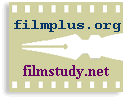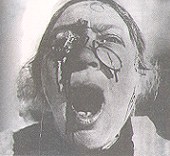Film * Stage * Web :
 |
| From 2009 |
t-blog --
...
|
* Caligari Project (stage) 2009
Film * Stage * Web :
t-blog -- ...
|
|
2007 film.vtheatre.net : Ch. 9 -- Film Art [347] Amadeus in class * textbook
sound in directing.filmplus.org Sound Effects and Narration Sound Motifs Music ...
 * Nondiegetic sound is sound which we do not recognize as part of the film world such as a voice-over or background music. Select OneLove-MeAfrica Mussorsky USA Piano Concert Symphony#1 Most likely we will try Radio Theatre @ Virtual Theatre, using streaming audio, which is more easy to broadcast. Very likely I have to make another page for this project. Last time I did Radio Theatre in Moscow, for Radio-Moscow. They closed the "Radio-Novel" project, because too many listeners got offended. I think the script (mine) was bad and it had nothing to do with the ideology. I tried my best to be Soviet. SummaryBefore I can direct anything, I have to see it. Sometimes you don't see, but your hear -- sounds, musics, melody... If I see, but do not hear, I am not ready.QuestionsNotes2004
Uses of Sound Types of Sound Sound in Relation to Picture Perceptual Characteristics of Sound Tech Theory new: chekhov.us * Russian Theatre (links in RU): fest.theatre.ru + cultu.ru (webcast)  * filmplus.org/kino * picasaweb.google.com/anatoly.antohin * my shared page google
* diggo [ new ] & 2010 AA Ethiopia * filmplus.org/kino * picasaweb.google.com/anatoly.antohin * my shared page google
* diggo [ new ] & 2010 AA Ethiopia
... Sound and Space, Sound and Time ...
|
 theatre theory and
theatre theory and  blog: anatoly-film
blog: anatoly-film

...sound gives a new value to silence.
Truly cinematic sound is neither merely accompanying sound (easy and explanatory) nor the natural sounds captured at the time of the simultaneus recording. In other words, cinematic sound is that which does not simply add to but multiplies, two or three times, the effect of the image. -- Akiro KurosawaIn Herbert Zettl's book SOUND comes in very late: chapter 16 and 17 (two last in the book) -- The Five-Dimensional Field. Why?
|
We are more consciously aware of what we see than of what we hear!
Visible & Invisible Sound Objective POV in Sound Subjective POV
Juxtaposition of Sound and Image Sound Effects Ambient Sounds
Sound as a Plot Device Sound as a Transitional Element
Voice-Over Dialogue
Homework Combination of Sound & Color Music
Music = a Base for Choreographed Action
|

Change the background sound and see how different the picture will be!Most of the notes for classes posted @ Directors Forum, the list I use for film classes (you are welcome to subscribe).Counter-point -- when sounds conflicts with image.
Read Eisenstein's chapter on sound.
Now you add the color dynamics (first field).
[see sound tract page]
Sound Structures
MUSIC:
Melody
Harmony
Homophony
Polyphony
Also, the further exploration of film topics at my new Virtual Theatre; we try to incorporate the streaming video technology in our theatre productions -- and the film techniques are important, of course! See for yourself -- WWWilde: Fall Y2K Production of "The Importance of Being Earnest" (check the links to 3 Sisters: Method & Realism and 12Night: Comedy & Biomechanics).
...
[ returm to soundtrack page ]
[ check the sound for stage pages ]
Selection, Alternation, and Combination: Choosing and Manipulating Sounds. Sound Mixing. Sound and Film Form. Sound and Perspective. Time. Music.








[ http://kn.open.ac.uk/public/getfile.cfm?documentfileid=846 ] ...It is easy to overlook the role of sound on film as simply that of accompanying the moving images. As Bordwell & Thompson (1986) demonstrate with a sequence from ‘Letter from Siberia” by Chris Marker, sound in a film can “actively shape how we interpret the image”. The sequence repeats the same four shots three times, each repetition accompanied by a different sound track. The commentary for each gives a completely different interpretation of the pictures, men that were working in the “joyful spirit of socialist emulation” on one commentary were “Bending like slaves” in the next. A viewer presented with either commentary would have little reason to doubt the description of the pictures as accurate.
Sound in a film can also direct the viewer’s attention to something in the image. A viewer will try to find the relevance of any image to the narrative and will soon pick out a known character from a crowd on the screen. Similarly sound can direct the viewer’s attention to what they should be looking at on screen. If the picture of a crowd was shown and the commentary said something about children, the viewer would automatically think “ah - it’s children that the narrative is talking about” and begin to pick out the children from the crowd.
Sound has an active interaction with the film image and narrative. Bordwell & Thompson (1986) use the example of a close-up of a person with the sound of a creaking door off-screen- the person looks up. If the next shot showed the open door, viewers would focus their attention on that. Or perhaps if the next shot showed a person in front of the door - they must have just entered. Or if the next shot showed a closed door then the viewers would ask themselves what the sound was. This way the sound has focused attention, clarified an event, or rendered an event ambiguous.
The sound of the door creaking would create the expectation that someone had entered the room. The viewer would expect the next shot to show who, but the director could stay on the shot of the man looking increasingly alarmed thus creating the impression something sinister is off-screen and creating tension. Even silence can be used for dramatic effect in film.
The correct sound adds depth and atmosphere to a scene (e.g. wind whistling or birds singing). Sound can be used over edits to make a relationship between locations (e.g., cut from loud party to darkness outside with muffled music some distance away). There are many possibilities.
David Bordwell and Kristin Thompson, Film Art: An Introduction, 6th ed. (New York: McGraw Hill, 2001)
Amadeus, trailer :
Part 1 [of 8?] --
FILM amazon
 2005-2006 Theatre UAF Season: Four Farces + One Funeral & Godot'06
2005-2006 Theatre UAF Season: Four Farces + One Funeral & Godot'06
![]() Copyright © 2007 by filmplus.org. Permission to link to this site is granted.
Copyright © 2007 by filmplus.org. Permission to link to this site is granted.
my books.google.com + scholar.google.com * eCitations *
www.everything2.com search!